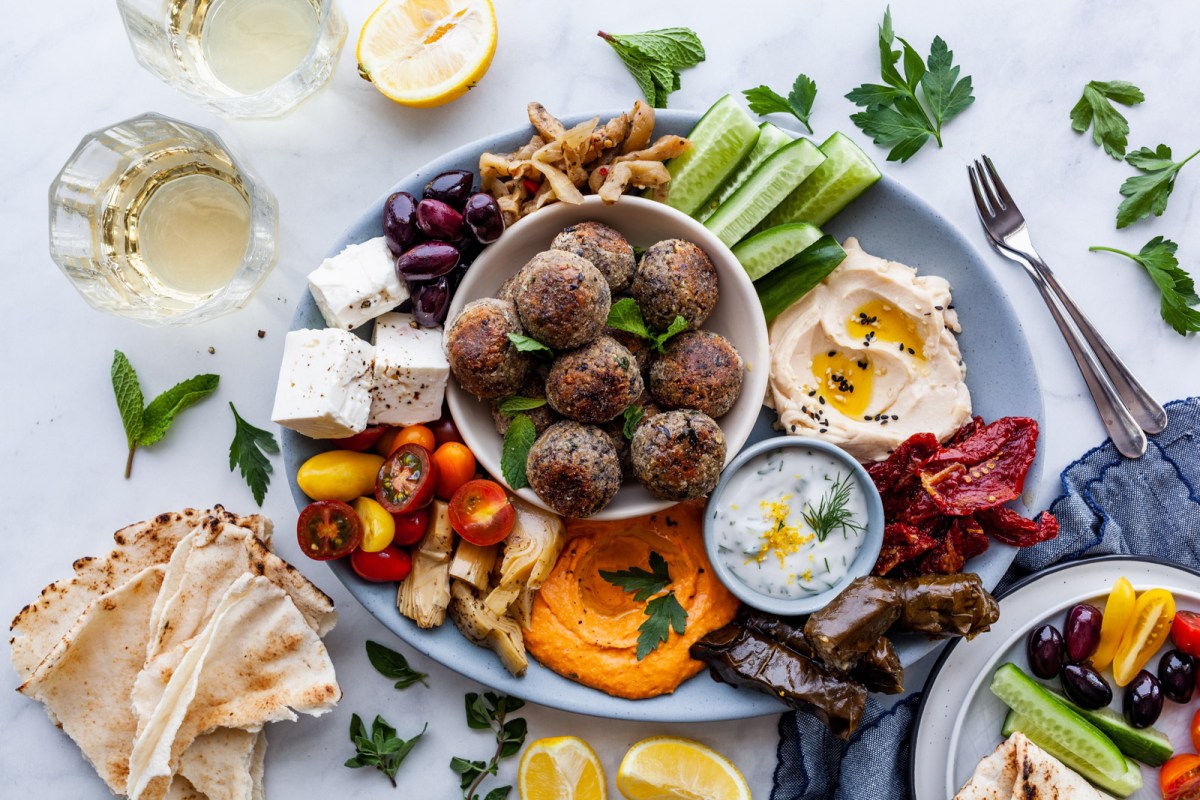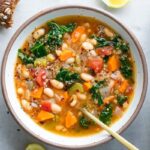Embark on a culinary journey through the sun-drenched landscapes of Greece, where vibrant vegetables and fragrant herbs transform into a symphony of vegan delights. Imagine succulent stuffed peppers bursting with Mediterranean flavors, creamy vegan moussaka layered with eggplant and potatoes, or flaky spanakopita filled with spinach and herbs. This exploration unveils the secrets behind the rich and satisfying taste of Greek vegan cuisine, showcasing dishes that are as visually stunning as they are delicious. We’ll delve into traditional techniques, explore innovative adaptations, and guide you through creating these masterpieces in your own kitchen.
From the bright acidity of lemon to the earthy warmth of oregano, the flavor profiles of Greek vegan cooking are as diverse as the islands themselves. We will uncover the artful balance of sweet, savory, and tart notes that define these dishes, demonstrating how simple ingredients combine to create unforgettable culinary experiences. Learn how to replicate the authentic tastes and textures, whether you’re a seasoned vegan chef or a curious newcomer to plant-based cooking.
Popular Greek Vegan Dishes
Greek cuisine, often perceived as meat-heavy, offers a surprising array of naturally vegan or easily adaptable dishes bursting with fresh, vibrant flavors. These dishes showcase the bounty of Mediterranean ingredients, highlighting vegetables, legumes, and herbs in exciting and satisfying ways. The following explores some of the most popular and delicious options.
Five Popular Greek Vegan Dishes and Their Preparation
Several traditional Greek dishes are naturally vegan or can be easily adapted to exclude animal products. These dishes emphasize the fresh, bright flavors characteristic of Greek cooking.
- Gigantes Plaki (Giant Baked Beans): This hearty dish features plump, giant white beans baked in a rich tomato sauce infused with herbs like oregano and dill, often with onions and garlic. Traditional recipes may include olive oil and sometimes a touch of lemon juice. The vegan adaptation is straightforward, simply ensuring the use of olive oil and avoiding any hidden animal products like fish stock sometimes used in non-vegan versions.
- Briam (Roasted Vegetables): A colorful medley of seasonal vegetables like eggplant, zucchini, potatoes, and bell peppers, roasted until tender and slightly caramelized. Drizzled with olive oil, herbs, and often a squeeze of lemon, Briam embodies the simplicity and freshness of Greek cuisine. The vegan version is identical to the traditional preparation.
- Horta (Boiled Greens): A simple yet flavorful dish of boiled greens, typically including dandelion greens, spinach, or chard. The greens are seasoned with olive oil, lemon juice, and often a sprinkle of salt. This is inherently vegan, celebrating the natural flavors of the greens.
- Fava (Yellow Split Pea Puree): A creamy and subtly sweet puree made from yellow split peas, often seasoned with olive oil, lemon juice, and onions. This dish is naturally vegan and offers a satisfying and nutritious alternative to other dips or spreads. A simple garnish of capers or olives adds further complexity.
- Spanakorizo (Spinach and Rice): This comforting dish combines spinach, rice, and onions, often cooked in vegetable broth and seasoned with lemon juice and herbs. The simplicity of this dish allows the flavors of the spinach and rice to shine through. It’s a naturally vegan option, easily made more flavorful with a touch of olive oil.
Nutritional Comparison of Popular Greek Vegan Dishes
The nutritional value of these dishes varies depending on portion size and specific ingredients, but a general comparison provides a helpful overview. These values are approximate and can change based on preparation methods and ingredient variations.
| Dish | Calories (per serving) | Protein (grams per serving) | Fiber (grams per serving) |
|---|---|---|---|
| Gigantes Plaki | 300-400 | 15-20 | 10-15 |
| Briam | 200-300 | 5-10 | 8-12 |
| Horta | 100-150 | 5-7 | 5-8 |
| Fava | 250-350 | 10-15 | 8-12 |
| Spanakorizo | 200-250 | 8-12 | 4-6 |
Flavor Profiles of Greek Vegan Cuisine
Greek vegan cuisine boasts a vibrant tapestry of flavors, far exceeding the simplistic notion of “just vegetables.” The magic lies in the masterful blending of fresh, high-quality ingredients and a deep understanding of how to coax out their inherent deliciousness. This is achieved through a thoughtful selection of herbs, spices, and acidic elements that create a symphony on the palate, reflecting the sun-drenched landscapes and rich culinary heritage of Greece.
The characteristic flavor profiles are built upon a foundation of bright, fresh ingredients. Think ripe tomatoes bursting with sweetness, fragrant olives lending their briny depth, and the assertive bite of lemon juice cutting through richness. These foundational elements are then layered with aromatic herbs like oregano, thyme, and mint, each contributing its unique personality to the dish. Spices, while used more sparingly than in some other cuisines, play a crucial role, with a touch of cinnamon or cloves sometimes adding warmth and complexity to stews and baked goods.
The Role of Herbs and Spices
The aromatic herbs of Greek cuisine are not mere garnishes; they are integral to the flavor profile. Oregano, with its earthy and slightly peppery notes, is ubiquitous, lending its distinctive character to everything from simple salads to hearty stews. Thyme, with its subtle lemony undertones, adds a delicate complexity, while mint offers a refreshing counterpoint to richer flavors. A sprinkle of dried dill can add a bright, almost citrusy note to vegan moussaka or other vegetable-based dishes. Spices, used judiciously, add layers of warmth and complexity. A pinch of cinnamon in a sweet potato and chickpea stew, or a whisper of cloves in a baked fig and walnut dessert, can elevate the dish to new heights.
Balancing Sweet, Sour, and Savory
Mastering the balance of sweet, sour, and savory is key to creating truly exceptional Greek vegan dishes. The sweetness often comes from ripe fruits like tomatoes, figs, or grapes, or from naturally sweet vegetables like sweet potatoes or carrots. Acidity is primarily provided by lemon juice, which is used generously to brighten flavors and cut through richness. Savory notes are derived from ingredients like olives, garlic, onions, and the aforementioned herbs and spices. The ideal balance involves a harmonious interplay of these three elements; a touch of sweetness to round out the flavors, a sufficient amount of acidity to provide brightness and balance, and enough savory notes to ground the dish and give it substance. For instance, in a vegan spanakopita, the sweetness of the spinach is balanced by the tartness of the lemon and the savory depth of the onions and herbs. This interplay creates a complex and satisfying flavor experience that perfectly encapsulates the essence of Greek cuisine.
Step-by-Step Recipes for Selected Dishes

These recipes offer a delicious journey into the heart of Greek vegan cuisine, showcasing the vibrant flavors and satisfying textures achievable without animal products. Each step is carefully detailed to ensure a successful and flavorful outcome, allowing you to recreate these classic dishes in your own kitchen. The descriptions emphasize the sensory experience of cooking, from the fragrant aromas to the evolving textures.
Vegan Moussaka
This comforting classic is reimagined with a hearty eggplant base and a creamy, flavorful vegan béchamel. The result is a dish that’s both visually stunning and incredibly satisfying. The layers of eggplant, potatoes, and the rich béchamel create a symphony of textures and flavors.
- Eggplant Preparation (30 minutes): Slice 2 large eggplants into 1/4-inch thick rounds. Salt both sides generously and let sit for 30 minutes to draw out excess moisture. This step is crucial for preventing a soggy moussaka. The eggplant will release a significant amount of liquid, leaving behind a softer, more absorbent texture.
- Potato Layer (20 minutes): While the eggplant rests, peel and thinly slice 2 large potatoes. Sauté the potatoes in 2 tablespoons of olive oil until slightly softened, about 10 minutes. The potatoes will release a light, earthy aroma as they cook, blending beautifully with the olive oil. Their texture will shift from firm to tender.
- Eggplant Cooking (25 minutes): Rinse the salted eggplant and pat dry thoroughly. Sauté the eggplant in 2 tablespoons of olive oil until golden brown on both sides. The eggplant will develop a rich, smoky aroma as it browns, and its texture will become tender yet firm.
- Vegan Béchamel (20 minutes): In a saucepan, melt 2 tablespoons of vegan butter. Whisk in 4 tablespoons of all-purpose flour to create a roux. Gradually whisk in 4 cups of plant-based milk (e.g., soy, almond, or oat), ensuring no lumps form. Add 1 teaspoon of nutmeg, salt, and pepper to taste. The béchamel will thicken as it simmers, releasing a warm, nutty aroma infused with the spices. The texture will transform from a thin liquid to a creamy, luscious sauce.
- Assembly and Baking (45 minutes): Preheat oven to 375°F (190°C). Layer the sautéed potatoes, eggplant, and a vegan meat substitute (optional) in a greased baking dish. Pour the béchamel sauce over the layers. Bake for 45 minutes, or until golden brown and bubbly. The moussaka will fill the kitchen with a rich, savory aroma as it bakes, the béchamel developing a golden-brown crust while maintaining its creamy interior. The eggplant and potatoes will be tender and infused with the flavors of the sauce.
Vegan Spanakopita
This flaky, spinach-filled pastry is a celebration of fresh herbs and earthy spinach. The layers of phyllo dough create a beautiful contrast in texture with the soft spinach filling. The aroma of warm phyllo and sautéed spinach is utterly irresistible.
- Prepare the Filling (20 minutes): Sauté 1 large onion, finely chopped, in 2 tablespoons of olive oil until softened. Add 10 ounces of fresh spinach, chopped, and cook until wilted. Stir in 1/2 cup of chopped fresh dill, 1/4 cup of chopped fresh mint, 1/4 cup of nutritional yeast, salt, and pepper to taste. The filling will release a vibrant, herbaceous aroma as the spinach cooks down. The texture will transform from crisp spinach to a soft, slightly wilted mixture.
- Prepare the Phyllo (15 minutes): Carefully unroll a package of phyllo dough, keeping it covered with a damp cloth to prevent drying. The phyllo dough will be incredibly delicate and thin.
- Assemble the Spanakopita (30 minutes): Brush a 9×13 inch baking dish with olive oil. Layer 3-4 sheets of phyllo dough in the dish, brushing each sheet with olive oil. Spread half of the spinach filling evenly over the phyllo. Top with another 3-4 sheets of phyllo, brushing each with olive oil. Spread the remaining filling on top. Fold the edges of the top phyllo sheets inward, creating a neat edge. The phyllo layers will create a beautiful, layered structure. The layers will be light and delicate.
- Bake (35 minutes): Bake at 375°F (190°C) for 35 minutes, or until golden brown and crispy. The spanakopita will fill your kitchen with a warm, savory aroma, the phyllo becoming golden brown and crisp, while the filling remains tender and flavorful. The final texture will be a delightful contrast between the crispy phyllo and the soft spinach filling.
As you savor the vibrant flavors and textures of these Greek vegan dishes, remember that each bite is a celebration of fresh, wholesome ingredients and the culinary heritage of Greece. From the simple elegance of a rustic salad to the comforting warmth of a hearty stew, these recipes offer a gateway to a world of plant-based possibilities. Experiment with variations, explore your creativity, and most importantly, enjoy the journey of discovering the delicious versatility of Greek vegan cuisine. The vibrant colors, enticing aromas, and satisfying textures will leave you wanting more, proving that vegan food can be both incredibly flavorful and deeply satisfying.
Essential Questionnaire
Can I make these dishes gluten-free?
Many traditional Greek dishes can be easily adapted to be gluten-free by substituting gluten-containing ingredients like flour or bread with gluten-free alternatives like almond flour or breadcrumbs.
Where can I find the specific ingredients?
Most ingredients are readily available at supermarkets or specialty stores. For harder-to-find items, consider online retailers specializing in Mediterranean or Greek ingredients.
How long do these dishes keep?
Leftovers generally store well in the refrigerator for 3-4 days. Freezing is also an option for longer storage; remember to allow for proper thawing before reheating.
Are these dishes suitable for meal prepping?
Absolutely! Many of these dishes are perfect for meal prepping, offering delicious and nutritious lunches or dinners throughout the week. Prepare larger batches and store them in airtight containers for easy grab-and-go meals.


